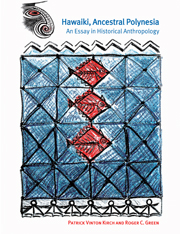Book contents
- Frontmatter
- Contents
- List of figures
- List of tables
- Preface
- List of language abbreviations
- Prologue: on historical anthropology
- Part I The phylogenetic model: theory and method
- Part II Rediscovering Hawaiki
- Epilogue: on history, phylogeny, and evolution
- Notes
- Glossary of terms
- References
- Subject Index
- Index of Proto Polynesian Reconstructions
Preface
Published online by Cambridge University Press: 06 January 2010
- Frontmatter
- Contents
- List of figures
- List of tables
- Preface
- List of language abbreviations
- Prologue: on historical anthropology
- Part I The phylogenetic model: theory and method
- Part II Rediscovering Hawaiki
- Epilogue: on history, phylogeny, and evolution
- Notes
- Glossary of terms
- References
- Subject Index
- Index of Proto Polynesian Reconstructions
Summary
Enchanted by the seductively salubrious atmosphere of California's Napa Valley, we gazed over sun-drenched vineyards with the 1993 harvest ripening on the vine, sipping the last of a lush Cabernet while intently arguing the intricacies of some Proto Polynesian term. Perhaps – given the blissful feeling this setting inspired – we might have been excused our conceit that we would conspire to write “a little essay between covers.” The notion, naive in retrospect, was to expand slightly on our 1987 article on “History, phylogeny, and evolution in Polynesia” (Kirch and Green 1987), so as to address certain critiques of the phylogenetic approach to historical anthropology, and to elaborate what we call a “triangulation method” for historical reconstruction. The proposition seemed straightforward enough. Yes, a “little essay,” perhaps a hundred pages or so. Over plates of roast Petaluma duck and grilled swordfish, our wives had seconded the idea, insisting that we should keep the essay lean and trim.
Nearly a decade later, our “essay” has taken shape as a book, a more ponderous volume than we at first envisioned. Its writing has occupied far longer than anticipated, requiring several international trips and much long-distance collaboration. Yet we do not regret the transformation that our project has undergone, because out of it we have gained a deeper respect for the possibilities of a truly integrative historical anthropology.
We were trained (at Penn and Yale, New Mexico and Harvard, respectively) in the classic holistic perspective of Americanist anthropology, and although we are both primarily archaeologists of the Pacific, each of us in our respective careers has endeavored to bring a full spectrum of anthropological evidence and approaches to bear in our research programs.
- Type
- Chapter
- Information
- Hawaiki, Ancestral PolynesiaAn Essay in Historical Anthropology, pp. xiii - xvPublisher: Cambridge University PressPrint publication year: 2001

